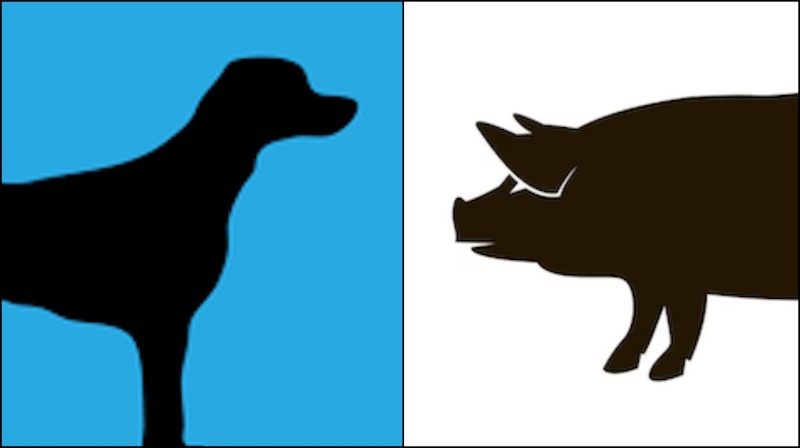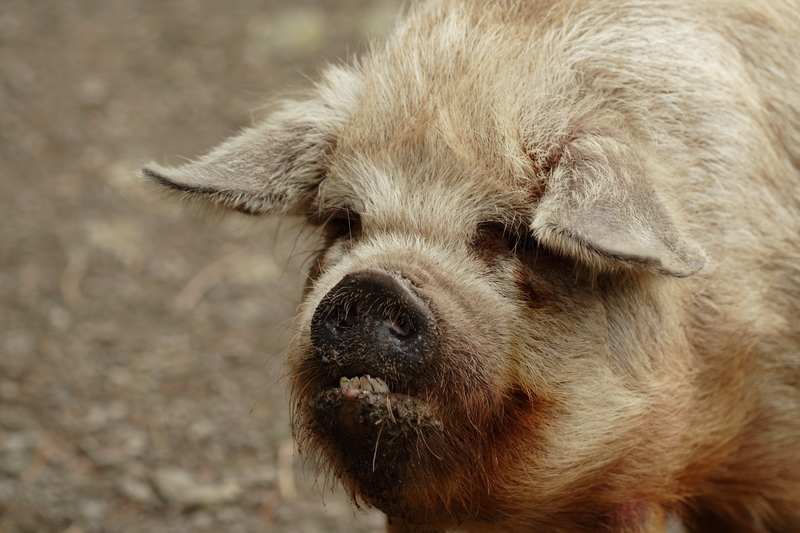
Just a guess, but since most of us will ever get close enough to a pig to examine its dentition, allow us to provide some factoids:
Pigs have a total of 44 permanent teeth in their adult dentition: Three incisors, one canine, four premolars, and three molars on each side of both the upper and lower jaws. As piglets, however, they are born with just eight teeth called “needle teeth.” Because piglets often use these teeth to hurt other piglets (usually to get the best spot at mom’s milk), or inadvertently injure mom, farmers often clip them soon after birth.
Like many mammals, pig are diphyodonts, which is to say that they get two sets of teeth for life, like humans. The adult teeth begin erupting at around four months old, starting with the molars. The rest of the permanent teeth (incisors, canines, and premolars) don’t push out the baby teeth until about eight months. By the time they’re a year old, pigs have all of their adult teeth.
There are benchmarks of tooth development which farmers and ranchers use to determine the age of a pig, handy to know when determining at what age a pig should be purchased (and why this matters has to do with whether a pig is bought to be fattened up, or kept to breed).
Pig dentition is complex, and pigs can have malocclusions like overbites and underbites. An overbite, or brachygnathia, occurs from a misalignment of incisors. An underbite, or prognathia, happens when the lower jaw protrudes further than the upper jaw. By and large, however, pigs naturally have an underbite.

Photo by ©Bruce Parrott | Dreamstime
Why on earth are we telling you this on a site that is purebred dog-centric?
Because only one AKC breed standard mentions a “pig-bite.” Only one. And it’s a serious enough fault to be a disqualification. From the English Foxhound’s standard: The teeth must meet squarely, either a pig-mouth (overshot) or undershot being a disqualification.
After a little digging, we learned that the term, “pig bite” used to describe an underbite malocclusion in a dog is not a widely recognized or standard terminology in veterinary dentistry, and that probably accounts for why only one dog standard uses the term; why the English Foxhound would be that one breed is a mystery to us. It’s possible that “pig bite” could have been a localized or breeder-specific term used to describe an underbite in this breed.
As to why an underbite would warrant a disqualification, it should first be noted that the standard states that the teeth must meet squarely. The English Foxhound is renowned for exceptional scenting abilities and endurance in fox hunting, and any condition that interferes with a dog’s ability to breathe or use their mouth efficiently could theoretically impact their hunting performance. We add that the current breed standard was approved in 1935 and has not deviated from that time. Perhaps it was thought that an underbite would make it challenging for a hunting dog to pick up food or drink water efficiently, and impact its ability to stay nourished and hydrated during long hunts. We’re all ears if any readers can shed additional information on this.
As for our post title, “in a pig’s eye” is an idiom used to express skepticism as something. The phrase, believed to be dated back to the late 19th century, may be a reference to the small size of a pig’s eyes, and thus, suggesting a narrow or limited perspective. It’s a polite substitution for, “You’re an idiot!” Since we have no explanation for why a “pig’s bite” is used in the English Foxhound standard, it seemed fitting for us to go with that expression.
